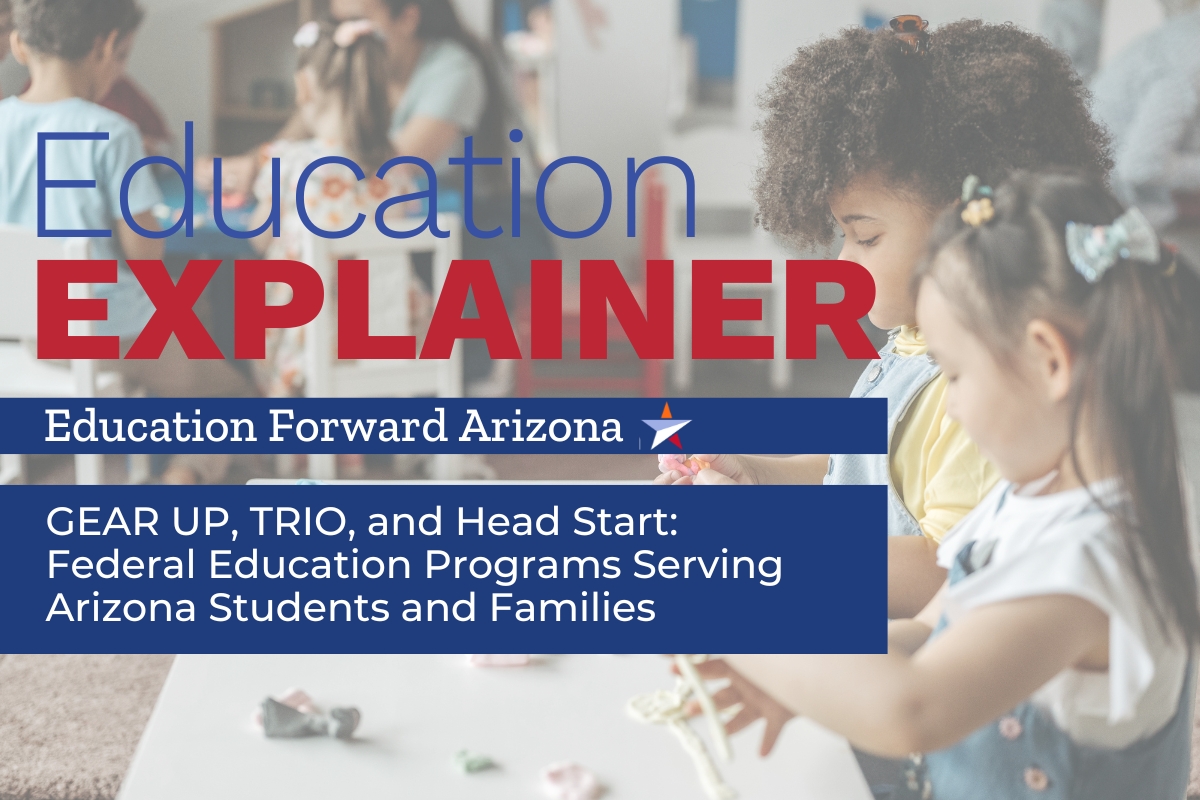
GEAR UP, TRIO, and Head Start: Federal Education Programs Serving Arizona Students and Families
Proposed cuts from the federal government for fiscal year 2026 have drawn attention to three long-standing federal programs: GEAR UP (Gaining Early Awareness and Readiness for Undergraduate Programs), TRIO, and Head Start. These programs have long been important in supporting low-income, first-generation, and rural students, particularly in states like Arizona, where underinvestment in education has led to outcomes below national averages. This Education Explainer explores the history of these programs, their impact on Arizona families, especially those in rural communities, and the potential implications of reducing or eliminating funding.
GEAR UP: Bridging the College Access Gap
Established in 1998 under the Higher Education Act, GEAR UP was designed to significantly increase the number of low-income students who are prepared to enter and succeed in postsecondary education. The program provides grants to states and local partnerships to support college preparation for entire groups of students starting in 7th grade, with every federal dollar matched by non-federal resources. GEAR UP has historically enjoyed bipartisan support, with lawmakers from both parties recognizing the importance of higher education access for underserved communities.
In Arizona, particularly in rural areas, Arizona GEAR UP has been a lifeline for students who might otherwise lack the resources and guidance to pursue higher education. The program has facilitated college tours, SAT preparation, and financial literacy workshops, empowering students to envision and work towards a college degree. Without GEAR UP, many students would face increased barriers to higher education, perpetuating cycles of poverty and limiting economic mobility.
Over the past two decades, Arizona GEAR UP has tracked measurable gains in educational attainment among participating students :
- High School Graduation: From 2006 to 2012, 83% of GEAR UP seniors graduated, compared to 73% statewide.
- College Enrollment: In the same period, 72% of GEAR UP graduates enrolled in college, versus 51% of their peers statewide.
- FAFSA Completion: Among the 2012–2019 cohort, 58% completed the Free Application for Federal Student Aid (FAFSA), compared to 47% at similar schools.
These outcomes align with Arizona’s educational goals, such as Achieve60AZ, which aims for 60% of Arizonans to hold a postsecondary degree, credential or certificate by 2030.
Since 2000, Arizona GEAR UP—led by Northern Arizona University through four consecutive statewide grants—has served over 61,000 students from 121 schools in 41 communities, combining personalized, long-term support with systemic partnerships to improve outcomes. With more than $182 million in combined federal and local resources, the program has consistently delivered results.
Arizona’s business community has long recognized that investments in programs like GEAR UP are essential to workforce development, helping students chart paths to meaningful careers and fueling a stronger state economy.
TRIO: Supporting First-Generation College Students
The Federal TRIO programs are eight outreach and student support initiatives that help individuals from disadvantaged backgrounds access and complete college. The first three—Upward Bound (1964), Talent Search (1965), and Student Support Services (1968)—gave the programs their name. Later reauthorizations of the Higher Education Act added others, including Veterans Upward Bound, Educational Opportunity Centers, and the McNair Postbaccalaureate Achievement Program. Like GEAR UP, TRIO enjoys bipartisan support for promoting educational access, but while TRIO supports individual students from high school through college completion, GEAR UP focuses on entire cohorts starting in middle school, to prepare them early for post-secondary success.
For Arizona’s rural communities, TRIO programs are especially helpful. Rural Arizona often struggles with lower high school graduation rates and college enrollment rates compared to urban areas. Challenges include limited access to college preparatory resources, fewer role models with college degrees, and the economic pressures that can make higher education seem out of reach. TRIO programs directly address these barriers by providing academic tutoring, college and career counseling, assistance with financial aid applications (FAFSA), campus visits, and mentorship.
TRIO programs in Arizona are helping more students get to and through college. At Arizona State University, Upward Bound reports a 98% high school graduation rate and 97% college enrollment among participants—strong outcomes for students who face significant barriers.
With services like tutoring, financial literacy, and career counseling, TRIO gives students the tools to succeed in college and beyond. These efforts not only open doors for individual students—they also help build a more skilled, competitive workforce for Arizona.
Head Start: Early Education for Vulnerable Children
Launched in 1965 as a cornerstone of President Lyndon B. Johnson’s “War on Poverty,” Head Start was designed as a comprehensive early childhood education, health, nutrition, and parent involvement program for low-income children and their families. It began as an eight-week summer demonstration project. It quickly garnered bipartisan support, recognized for its potential to break cycles of poverty by providing a foundation for lifelong learning and success. The program was most recently reauthorized with strong bipartisan backing in 2007.
In Arizona, where recent reports show more than 17,000 children benefit from Head Start, the program is a lifeline, particularly in rural areas. The Children’s Action Alliance and other sources highlight that many rural Arizona communities lack sufficient licensed childcare centers, and Head Start often fills this void. These programs provide a safe and enriching environment for children, enabling parents to work or pursue further education. For rural Arizona, characterized by significant distances to resources and often higher rates of poverty, Head Start centers are usually one of the few, if not the only, providers of comprehensive early childhood services. They offer crucial health and developmental screenings, nutritious meals, and support for otherwise inaccessible families.
The economic benefits of Head Start are well-documented. Nationally, studies have shown that every dollar invested in Head Start can yield a return of $7 to $9 in terms of increased lifetime earnings, reduced healthcare costs, and decreased reliance on public assistance. In Arizona, Head Start enables parents to participate in the workforce, contributing to local and state economies. The program itself employs local staff and often purchases goods and services from local businesses.
Economic and Social Consequences for Arizona
The potential elimination of GEAR UP and TRIO could have serious economic and social implications for communities across Arizona, especially in rural areas. While Head Start has retained federal funding for now, the closure of the regional office overseeing Arizona has disrupted service delivery in several communities.
GEAR UP, TRIO, and Head Start contribute to the local economy by employing educators and support staff and partnering with schools, nonprofits, and local institutions. Beyond their economic impact, these programs provide critical support for low-income and first-generation students, helping to break cycles of poverty through increased access to education and opportunity. With a long history of bipartisan support, they have played an essential role in advancing educational access in Arizona. Limiting or eliminating these programs risks undermining both individual success and the state’s broader goals for economic growth and community wellbeing.
All Arizonans deserve the opportunity to contribute to their communities and futures through equal access to education.


